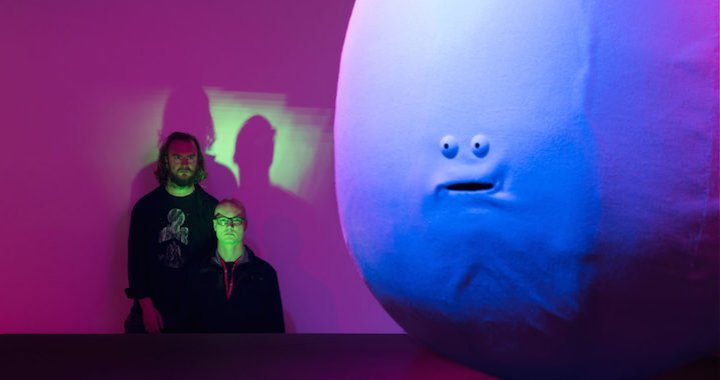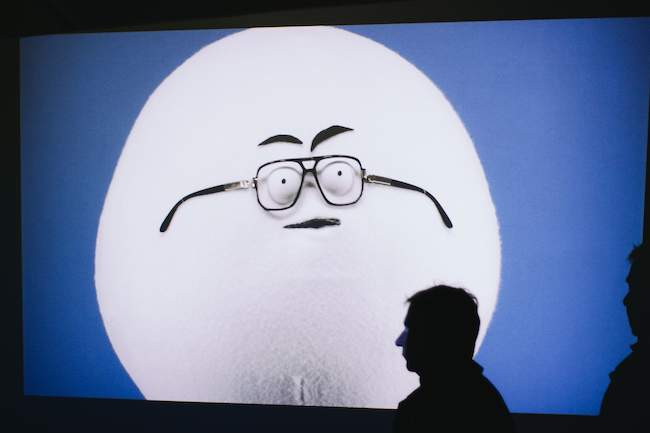
A cosmic perspective on nationalism
A short conversation with Erkka Nissinen, one of the artists presenting at Finland’s national pavilion at the 57th Venice Biennale
25/05/2017
On 13 May, in Venice’s Giardini, the project “The Aalto Natives” – by Nathaniel Mellors and Erkka Nissinen – opened the Finnish pavilion of the 57th Venice Biennale. Individually known for their irreverent and often comedic story-driven work, in which a humorous approach deceivingly belies a profound inquiry into contemporary issues of morality and power, Mellors and Nissinen focus on various clichés surrounding Finnish history and national identity. The installation is conceived for the architectural and ideological context of the Finnish Pavilion which was designed by the architect Alvar Aalto in 1956. Conflating ideas and tropes from archaeology, anthropology and science fiction, it is re-imagining Finnish society.
“We wanted to take a cosmic perspective on nationalism – a comic-cosmic perspective on national identity, creation mythology, transnational movement, bureaucracy, and class and racial stereotyping. We started with the idea of creation mythology – it seemed both absurd and necessary. We took a trip to the the Ateneum in Helsinki, looked at the Kalevala paintings, and talked about the role of the egg-laying duck. We realized that Finland is part of a broader genus of egg-based civilizations,” say the artists.
It was humor that first attracted Nissinen and Mellors to each other’s work. The artists met during their residency at the Rijksakademie in Amsterdam in 2007. Since then they have shared ideas, appeared in each other’s works, and have exhibited together in exhibitions. But “The Aalto Natives”, on which they are also working with curator Xander Karskens from De Hallen Haarlem in the Netherlands, is their first joint project.
We contacted one of the creators of “The Aalto Natives”, Erkka Nissinen, to find out more about this intriguing project. He has studied at both The Slade School of Fine Art in London and the Academy of Fine Arts in Helsinki, Finland. His works have been exhibited internationally in such venues as the Ellen de Bruijne Project Space in Amsterdam, the Smart Projects Space in Amsterdam, the Helsinki Art Museum’s Kluuvi Gallery, and at 1646 in Den Haag. At the 2011 Rotterdam Art Fair, Nissinen won the acclaimed Illy Prize. In 2013 he was awarded the AVEK Prize for media art.
Nathaniel Mellors and Erkka Nissinen. The Aalto Natives at Finland's pavilion. Photo: Agnija Grigule
The Aalto Natives project promises to explore different stereotypes of Finnishness. What would you like the viewer to turn their attention to when looking at your work? Is there anything they should focus on particularly?
I have no personal interest in controlling the viewer’s focus. The work touches upon the theme of nationality, but I hope that this piece will go into a somewhat stranger place instead of just communicating the themes of the pavilion or the Venice Biennale.
Does this mean that you don’t really care about the theme of the Biennale – Viva Arte Viva!?
I didn’t know what the theme was; I wasn’t even aware that there was one. Regarding the Finnish pavilion – the state was really looking for a national project, the reason being that Finland is celebrating 100 years since its declaration of independence. Our work corresponds to that theme.
I like the phrase you use when speaking about the project – a cosmic perspective on nationalism. What’s so cosmic about the project?
It is a story of terra-forming aliens – aliens who are able to make civilization, to create landmarks. They are creating Finland on a distant planet – it is like a science fiction story that follows the creation of Finland.
What does national identity mean to you? Do you consider yourself a Finnish artist?
I haven’t lived in Finland for the last 15–16 years, but as a person, I still feel like I’m very Finnish. I’m still “in character”.
So, you fit in with the stereotypes.
I am the personification of those stereotypes.
And what are these stereotypes?
Finnish people are sort of non-communicative and shy, very regional, etc. Finland is such an isolated country, geographically, that I think that that strongly affects the so-called “Finnish identity”.
What should the viewer be aware of in order to best understand your work? Would it help if they personally knew a Finn?
It is a very approachable work. Nathaniel and I both work quite a lot with comedy, and there are always elements in our work that are very easy to understand immediately. There might be some underlying ideas that won’t reveal themselves to everybody immediately, but there are a lot of elements that you can appreciate without knowing much about the piece.
In your previous works you’ve exhibited a “do-it-yourself” attitude; did you use the same approach for this work?
Very much so. We basically do everything ourselves. The piece won’t be completely finalized and fine-tuned – that’s a quality that comes along with making DIY things. And that’s also the kind of aesthetics that I like.
And there will be a talking egg...
Yes.
In interviews, you’ve spoken about egg-based civilizations... Could you explain that a bit more?
Yes. There is always an egg in the beginning.
What came first – the egg or the chicken?
Yes.
Are you saying that it was the egg?
In this case, it is difficult to say. It is not clear. It is a universal question that nobody can answer.
How did it all start? What was the first impulse that sparked the idea for this work?
I guess it was the theme of the pavilion, which was very much connected to national identity. I thought there was already a kind of a comedy in the theme itself. It was an open call for artists. I never collaborated with anybody before, and I was thinking it would be nice to try to do so, and maybe learn from that. I appreciate Nathaniel Mellors’ work quite a lot. There is some kind of connection between our works, so I suggested to him that we make a proposal for the Finnish pavilion. I thought we probably wouldn’t get it, but it could lead to another work or a film that could be developed from the initial idea.
How did the process of working together go?
Nathaniel is a very good writer – that is one of his aspects that I am very interested in. We talk about ideas and he writes most of the dialogue. Then we work out all the rest together. There are also parts where one of us is more in charge. Of course, collaboration is very challenging – we have to find solutions to different approaches, which makes this project very interesting in that sense. For instance, there might be different directions that we both want to pull towards, but we need to find a solution that fits both of us.
Do you fight?
Never. All the time! [Laughs]
Can we look at the project in the context of political events that took place in the world last year?
What we are doing might seem to relate to what is happening in politics now, but that’s by accident. Somehow, the world has started to mirror our work. We have been working on this project for a year now. When we started, none of these things – Brexit or the USA elections – had happened yet. Of course, it puts the work in a different light, I suppose, or maybe it adds something to it. But I would say that that will probably be the case with a lot of the works in the Venice Biennale. I would guess that current political events will somehow be reflected in works even if, in the beginning, that wasn’t the intention.
Humor is an important tool that you use in your works to express an idea. What is your opinion of contemporary art today – isn’t it a little too serious?
I’m not a very academic artist. I’m not interested in communicating academic ideas, but I am not against them, either. I think academic work can be interesting, but for myself, I am more interested when the work goes into stranger places than just the communication of ideas.
Stranger places?
Strange or surprising places.
Do you see yourself as a socially active artist?
Me? No. I usually don’t really react to current world events in my work.
That’s right, you said that events react to your work...
Yes, exactly!
How much is the curator, Xander Karskens, involved in the project?
We are working with him very closely. He is very much involved with the publication that is coming out about this work, and writing about it. He is also producing the work.
More about Finland’s national exposition: frame-finland.fi
